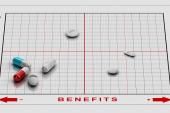Meta-analysis of Pivotal SGLT2 Inhibitor Trials Boosts Hopes in HFpEF
Accumulating data suggest a class effect of the drugs across a range of LVEF as all eyes turn to DELIVER trial, notes Deepak Bhatt.

A meta-analysis of nearly 10,000 patients adds more evidence that sodium-glucose cotransporter 2 (SGLT2) inhibitors are useful in heart failure with preserved ejection fraction (HFpEF).
Although originally developed to treat type 2 diabetes, SGLT2 inhibitors are guideline-recommended therapy for heart failure with reduced ejection fraction (HFrEF). The recent EMPEROR-Preserved trial suggested they also may reduce CV death and worsening heart failure in patients with HFpEF, with or without diabetes.
On the background of that, the new meta-analysis of five trials and four SGLT2 inhibitors found that patients with HF and ejection fraction > 40% who took the medications and were followed for up to 2 years had reductions in CV death or HF hospitalization (HR 0.78; 95% CI: 0.69-0.87) and HF hospitalization alone (HR 0.71; 95% CI 0.61-0.84) compared with placebo.
Senior author Vassilios S. Vassiliou MBBS, PhD (University of East Anglia, Norwich, England), said in the absence of large RCTs in HFpEF patients, the meta-analysis provides “strong evidence” of benefit with SGLT2 inhibitors.
“That's quite important, because nothing else has managed to do that so far,” he told TCTMD. “Within its limitations, it's quite an optimistic result.”
‘True’ HFpEF Subanalysis Performed
The research was published online ahead of print as a research letter in the European Journal of Preventive Cardiology and led by Vasiliki Tsampasian, MD, MSc (Norfolk and Norwich University Hospitals, England). It included EMPEROR-Preserved with empagliflozin (Jardiance; Boehringer Ingelheim/Eli Lilly), VERTIS-CV with ertugliflozin (Steglatro; Merck Sharp & Dohme), DECLARE-TIMI 58 with dapagliflozin (Forxiga/Farxiga; AstraZeneca), and SOLOIST-WHF and SCORED, both with sotagliflozin (Zynquista; Sanofi Aventis/Lexicon).
Overall, the were no differences between the placebo and SGLT2 inhibitor groups in rates of CV death (HR 1.01; 95% CI 0.80-1.28) or all-cause death (HR 1.01; 95% CI 0.89-1.14).
Since all of the trials in the meta-analysis included some patients with midrange or mildly preserved LVEF (< 50%), a subanalysis was performed of those with LVEF of > 50% (n = 5,928). The former are a current point of contention since they are no longer considered to be true HFpEF patients in the recently released European guidelines—although they were at the time the studies in the meta-analysis were conducted.
Within its limitations, it's quite an optimistic result. Vassilios S. Vassiliou
The subanalysis of the so-called “true” HFpEF patients also showed a benefit of SGLT2 inhibitors compared with placebo, with a reduction in the endpoint of CV death or HF hospitalization (HR 0.77; 95% CI 0.66-0.91). Analysis of the individual trials and subpopulations showed similar though less-dramatic benefits in those with higher LVEF. In the EMPEROR-Preserved group with LVEF of greater than 50% but less than 60%, for example, empagliflozin was associated with a reduction in CV death or HF hospitalization at an HR of 0.80 (95% CI 0.64-1.00), and in the subgroup of LVEF > 60% the HR was 0.87 (95% CI 0.69-1.10).
The results in the meta-analysis are in line with a detailed analysis recently presented by the EMPEROR-Preserved investigators at the virtual American Heart Association 2021 Scientific Sessions. Compared with placebo, empagliflozin was associated with a significant reduction in the primary composite endpoint of CV death or first HF hospitalization, driven by a reduction in first HF hospitalizations in patients with an LVEF of 50% or higher. There was no significant difference between the placebo and empagliflozin groups in terms of CV death.
To TCTMD, Vassiliou said even if the primary benefit of SGLT2 inhibitors in those with preserved EF is a reduction in HF-related hospitalizations rather than a direct impact on mortality, it is an important endpoint in terms of both quality of life and cost-effectiveness.
“The average follow-up for the patients in our meta-analysis was just over 2 years, though, so it is possible that if they were to be followed up longer, we might have seen an effect on cardiovascular mortality or overall mortality,” he noted.
Suggestive of Class Effect
Deepak Bhatt, MD, MPH (Brigham and Women’s Hospital, Boston, MA), who was the lead author of SOLOIST-WHF and SCORED, as well as senior author of a review and meta-analysis of the same studies prior to EMPEROR-Preserved’s publication, said accumulating data suggest a class effect across a range of LVEF.
The story continues to unfold, but at this point in time, there's a lot of data and momentum for SGLT2 inhibitor use and lots of different guidelines for adopting their use. Deepak Bhatt
“With EMPEROR-Preserved added in this meta-analysis, it strengthens the signal that we are seeing,” Bhatt told TCTMD. “There's really enough data now to use SGLT2 inhibitors in patients with symptomatic heart failure across the whole spectrum of ejection fraction, assuming side effects or cost are not issues.” Although the price of the drugs is a potential barrier to their uptake, Bhatt said they may be cost-effective if they are shown to offset expensive rehospitalizations in HFpEF patients.
Vassiliou and Bhatt both said all eyes now are on the DELIVER trial, which is currently recruiting at 335 centers and aims to include over 6,000 HFpEF patients without diabetes. The international RCT will evaluate dapagliflozin for reducing CV death or worsening HF in patients with LVEF > 40% and evidence of structural heart disease.
“Some people have labeled [SGLT2] inhibitors ‘smart diuretics,’ and I think there is some wisdom to that classification. They do help decongest patients and get fluid off, but in a way that's safe and that doesn't cause imbalances in their potassium levels and doesn't increase arrhythmia, such as atrial fibrillation,” he added. “The story continues to unfold, but at this point in time, there's a lot of data and momentum for SGLT2 inhibitor use and lots of different guidelines for adopting their use.”
L.A. McKeown is a Senior Medical Journalist for TCTMD, the Section Editor of CV Team Forum, and Senior Medical…
Read Full BioSources
Tsampasian V, Elghazaly H, Chat R, et al. Sodium glucose co-transporter 2 inhibitors in heart failure with preserved ejection fraction: a systematic review and meta-analysis. Eur J Prev Cardiol. 2021;Epub ahead of print.
Disclosures
- The authors report no relevant conflicts of interest.
- Bhatt reports receiving research funding or unfunded research support from Abbott, Amarin, Amgen, AstraZeneca, Bayer, Boehringer Ingelheim, Bristol-Myers Squibb, Chiesi, Eisai, Ethicon, Forest Laboratories, Idorsia, Ironwood, Ischemix, Lilly, Medtronic, PhaseBio, Pfizer, Regeneron, Roche, Sanofi, Synaptic, The Medicines Company, FlowCo, Merck, Novo Nordisk, PLx Pharma, and Takeda; being a site co-investigator for Biotronik, Boston Scientific, St. Jude Medical, and Svelte; being a trustee for ACC; serving as an advisory board member, director, or chair for Cardax, Elsevier Practice Update Cardiology, Medscape Cardiology, Regado Biosciences; the Boston VA Research Institute, the Society of Cardiovascular Patient Care, TobeSoft; the American Heart Association Quality Oversight Committee; serving on a range of data safety monitoring committees; receiving honoraria for editorial or committee activities for a range of publications and organizations; and receiving royalties from Elsevier.





Comments